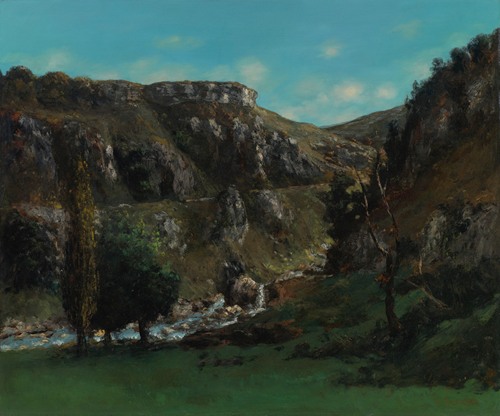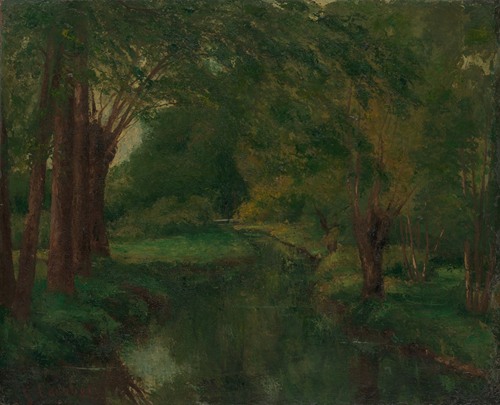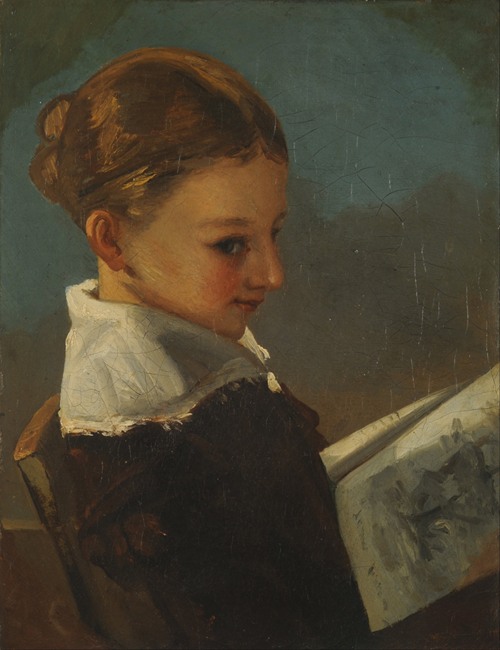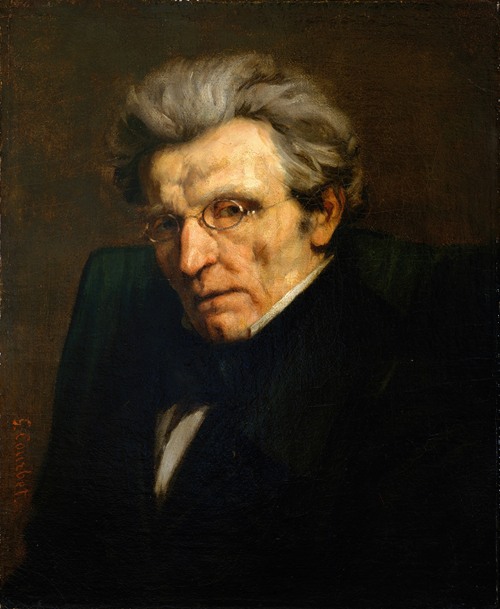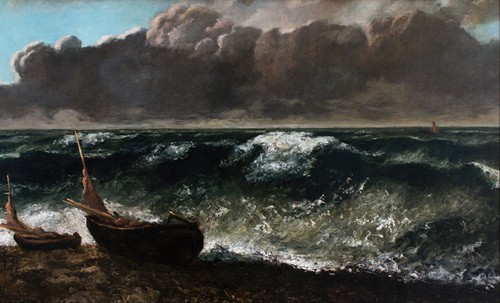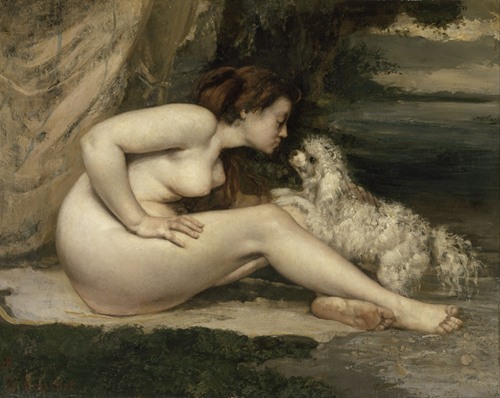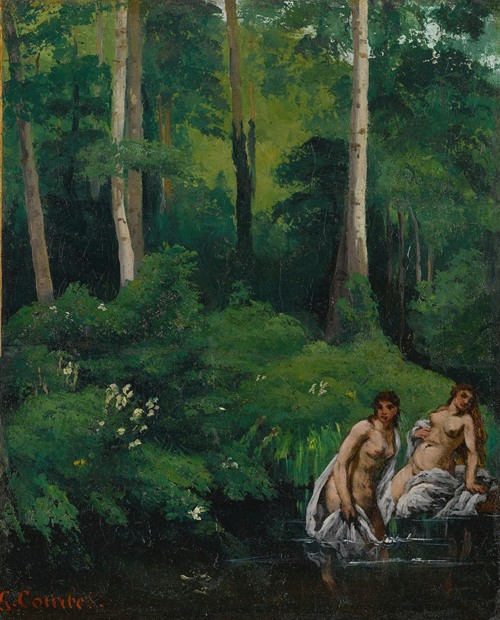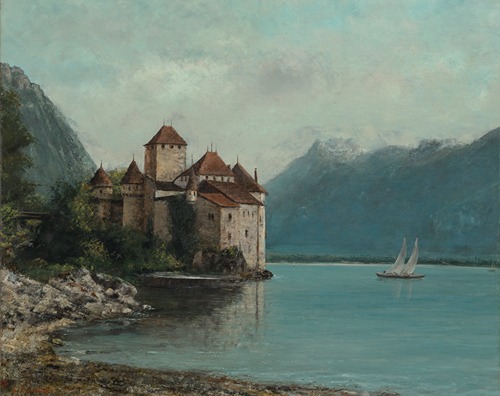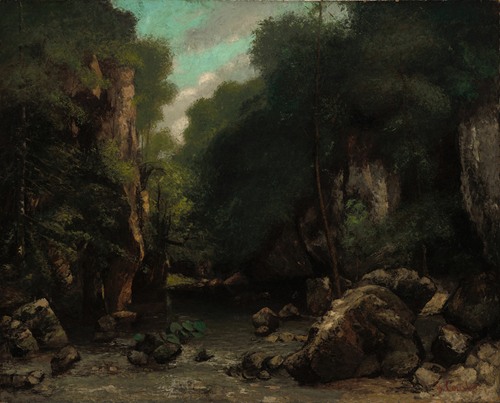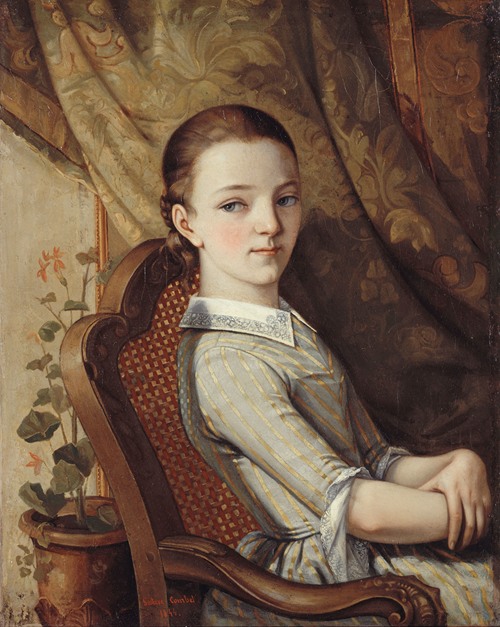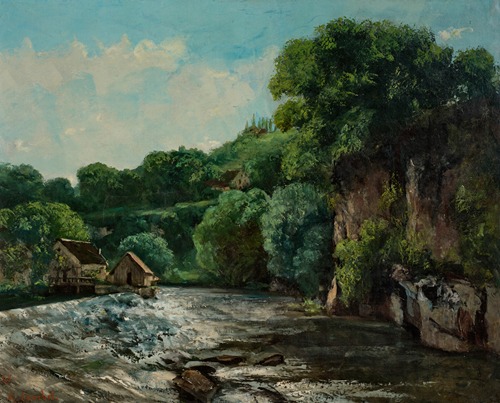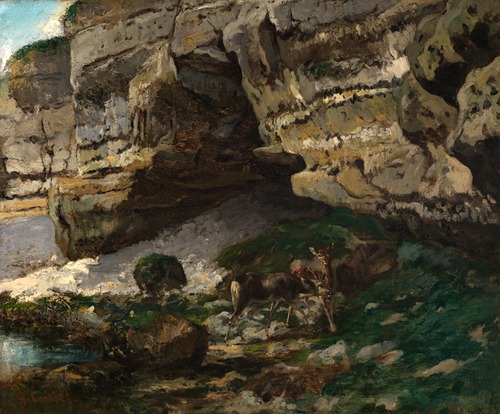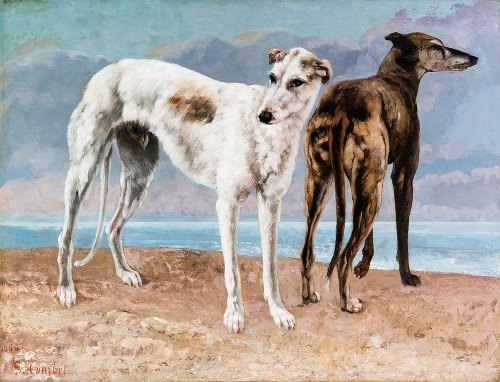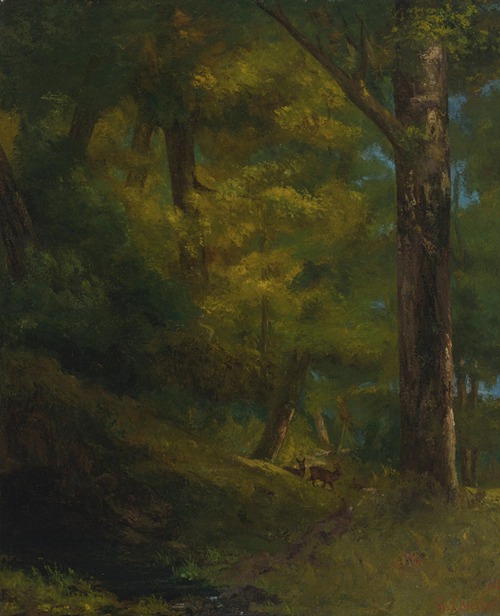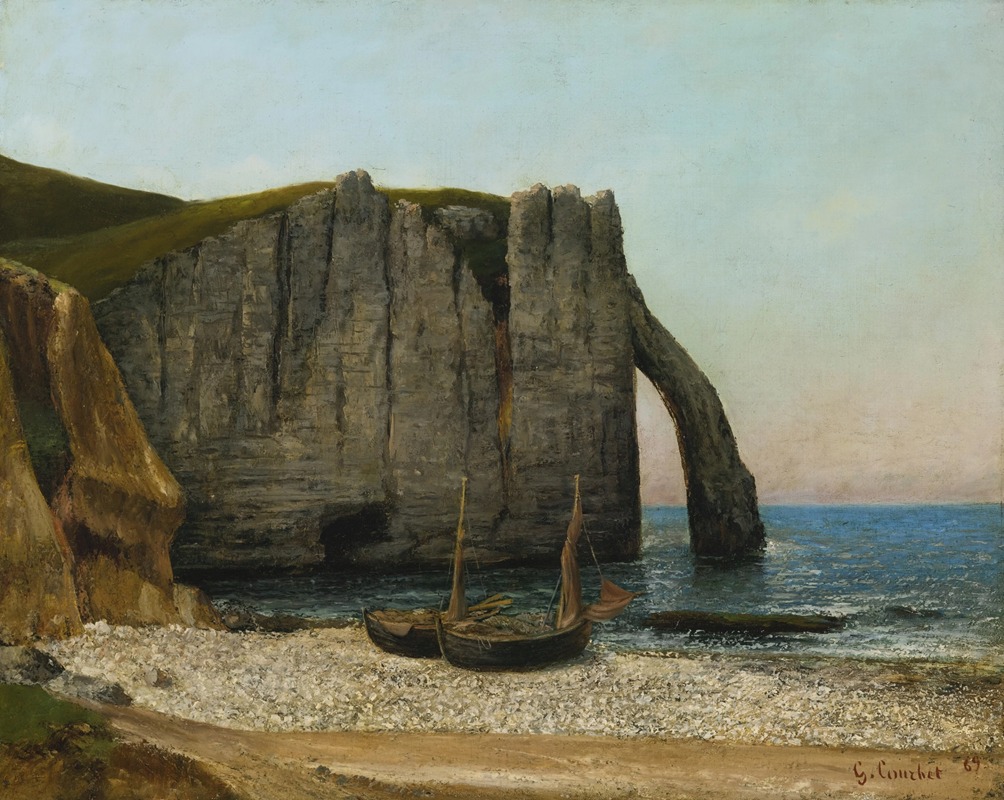
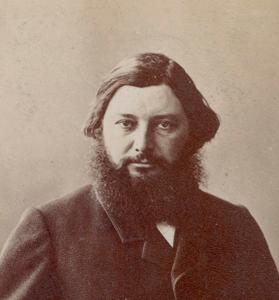
Jean Désiré Gustave Courbet was a French painter who led the Realism movement in 19th-century French painting. Committed to painting only what he could see, he rejected academic convention and the Romanticism of the previous generation of visual artists. His independence set an example that was important to later artists, such as the Impressionists and the Cubists. Courbet occupies an important place in 19th-century French painting as an innovator and as an artist willing to make bold social statements through his work.
Courbet's paintings of the late 1840s and early 1850s brought him his first recognition. They challenged convention by depicting unidealized peasants and workers, often on a grand scale traditionally reserved for paintings of religious or historical subjects. Courbet's subsequent paintings were mostly of a less overtly political character: landscapes, seascapes, hunting scenes, nudes, and still lifes. Courbet, a socialist, was active in the political developments of France. He was imprisoned for six months in 1871 for his involvement with the Paris Commune, and lived in exile in Switzerland from 1873 until his death.
Gustave Courbet was born in 1819 to Régis and Sylvie Oudot Courbet in Ornans (department of Doubs). Being a prosperous farming family, anti-monarchical feelings prevailed in the household.[clarification needed] (His maternal grandfather fought in the French Revolution.) Courbet's sisters, Zoé, Zélie, and Juliette, were his first models for drawing and painting. After moving to Paris he often returned home to Ornans to hunt, fish and find inspiration.
Courbet went to Paris in 1839 and worked at the studio of Steuben and Hesse. An independent spirit, he soon left, preferring to develop his own style by studying the paintings of Spanish, Flemish and French masters in the Louvre, and painting copies of their work.
Courbet's first works were an Odalisque inspired by the writing of Victor Hugo and a Lélia illustrating George Sand, but he soon abandoned literary influences, choosing instead to base his paintings on observed reality. Among his paintings of the early 1840s are several self-portraits, Romantic in conception, in which the artist portrayed himself in various roles. These include Self-Portrait with Black Dog (c. 1842–44, accepted for exhibition at the 1844 Paris Salon), the theatrical Self-Portrait which is also known as Desperate Man (c. 1843–45), Lovers in the Countryside (1844, Musée des Beaux-Arts, Lyon), The Sculptor (1845), The Wounded Man (1844–54, Musée d'Orsay, Paris), The Cellist, Self-Portrait (1847, Nationalmuseum, Stockholm, shown at the 1848 Salon), and Man with a Pipe (1848–49, Musée Fabre, Montpellier).
Trips to the Netherlands and Belgium in 1846–47 strengthened Courbet's belief that painters should portray the life around them, as Rembrandt, Hals and other Dutch masters had. By 1848, he had gained supporters among the younger critics, the Neo-romantics and Realists, notably Champfleury.
Courbet achieved his first Salon success in 1849 with his painting After Dinner at Ornans. The work, reminiscent of Chardin and Le Nain, earned Courbet a gold medal and was purchased by the state. The gold medal meant that his works would no longer require jury approval for exhibition at the Salon—an exemption Courbet enjoyed until 1857 (when the rule changed).
In 1849–50, Courbet painted The Stone Breakers (destroyed in the Allied Bombing of Dresden in 1945), which Proudhon admired as an icon of peasant life; it has been called "the first of his great works". The painting was inspired by a scene Courbet witnessed on the roadside.
Courbet's work belonged neither to the predominant Romantic nor Neoclassical schools. History painting, which the Paris Salon esteemed as a painter's highest calling, did not interest him, for he believed that "the artists of one century [are] basically incapable of reproducing the aspect of a past or future century ..." Instead, he maintained that the only possible source for living art is the artist's own experience. He and Jean-François Millet would find inspiration painting the life of peasants and workers.
Courbet painted figurative compositions, landscapes, seascapes, and still lifes. He courted controversy by addressing social issues in his work, and by painting subjects that were considered vulgar, such as the rural bourgeoisie, peasants, and working conditions of the poor. His work, along with that of Honoré Daumier and Jean-François Millet, became known as Realism. For Courbet realism dealt not with the perfection of line and form, but entailed spontaneous and rough handling of paint, suggesting direct observation by the artist while portraying the irregularities in nature. He depicted the harshness in life, and in doing so challenged contemporary academic ideas of art.
Considered to be the first of Courbet's great works, The Stone Breakers of 1849 is an example of social realism that caused a sensation when it was first exhibited at the Paris Salon of 1850. The work was based on two men, one young and one old, whom Courbet discovered engaged in backbreaking labor on the side of the road when he returned to Ornans for an eight-month visit in October 1848. On his inspiration, Courbet told his friends and art critics Francis Wey and Jules Champfleury, “It is not often that one encounters so complete an expression of poverty and so, right then and there I got the idea for a painting.”
While other artists had depicted the plight of the rural poor, Courbet's peasants are not idealized like those in works such as Millet's The Gleaners.
In February 1945, the work was destroyed during World War II, along with 154 other pictures, when a transport vehicle moving the pictures to the castle of Königstein, near Dresden, was bombed by Allied forces.
The Salon of 1850–1851 found him triumphant with The Stone Breakers, the Peasants of Flagey and A Burial at Ornans. The Burial, one of Courbet's most important works, records the funeral of his grand uncle which he attended in September 1848. People who attended the funeral were the models for the painting. Previously, models had been used as actors in historical narratives, but in Burial Courbet said he "painted the very people who had been present at the interment, all the townspeople". The result is a realistic presentation of them, and of life in Ornans.
The vast painting, measuring 10 by 22 feet (3.0 by 6.7 meters), drew both praise and fierce denunciations from critics and the public, in part because it upset convention by depicting a prosaic ritual on a scale which would previously have been reserved for a religious or royal subject.
According to art historian Sarah Faunce, "In Paris the Burial was judged as a work that had thrust itself into the grand tradition of history painting, like an upstart in dirty boots crashing a genteel party, and in terms of that tradition it was of course found wanting." The painting lacks the sentimental rhetoric that was expected in a genre work: Courbet's mourners make no theatrical gestures of grief, and their faces seemed more caricatured than ennobled. The critics accused Courbet of a deliberate pursuit of ugliness.
Eventually, the public grew more interested in the new Realist approach, and the lavish, decadent fantasy of Romanticism lost popularity. Courbet well understood the importance of the painting, and said of it, "The Burial at Ornans was in reality the burial of Romanticism."
Courbet became a celebrity, and was spoken of as a genius, a "terrible socialist" and a "savage". He actively encouraged the public's perception of him as an unschooled peasant, while his ambition, his bold pronouncements to journalists, and his insistence on depicting his own life in his art gave him a reputation for unbridled vanity.
In 1855, Courbet submitted fourteen paintings for exhibition at the Exposition Universelle. Three were rejected for lack of space, including A Burial at Ornans and his other monumental canvas The Artist's Studio. Refusing to be denied, Courbet took matters into his own hands. He displayed forty of his paintings, including The Artist's Studio, in his own gallery called The Pavilion of Realism (Pavillon du Réalisme) which was a temporary structure that he erected next door to the official Salon-like Exposition Universelle.
In the Salon of 1857, Courbet showed six paintings. These included Young Ladies on the Banks of the Seine (Summer), depicting two prostitutes under a tree, as well as the first of many hunting scenes Courbet was to paint during the remainder of his life: Hind at Bay in the Snow and The Quarry.
Young Ladies on the Banks of the Seine, painted in 1856, provoked a scandal. Art critics accustomed to conventional, "timeless" nude women in landscapes were shocked by Courbet's depiction of modern women casually displaying their undergarments.
By exhibiting sensational works alongside hunting scenes, of the sort that had brought popular success to the English painter Edwin Landseer, Courbet guaranteed himself "both notoriety and sales". During the 1860s, Courbet painted a series of increasingly erotic works such as Femme nue couchée.
This culminated in The Origin of the World (L'Origine du monde) (1866), which depicts female genitalia and was not publicly exhibited until 1988, and Sleep (1866), featuring two women in bed. The latter painting became the subject of a police report when it was exhibited by a picture dealer in 1872.
On 4 September 1870, during the Franco-Prussian War, Courbet made a proposal that later came back to haunt him. He wrote a letter to the Government of National Defense, proposing that the column in the Place Vendôme, erected by Napoleon I to honour the victories of the French Army, be taken down. He wrote:
In as much as the Vendôme Column is a monument devoid of all artistic value, tending to perpetuate by its expression the ideas of war and conquest of the past imperial dynasty, which are reproved by a republican nation's sentiment, citizen Courbet expresses the wish that the National Defense government will authorize him to disassemble this column."
Courbet proposed that the Column be moved to a more appropriate place, such as the Hotel des Invalides, a military hospital. He also wrote an open letter addressed to the German Army and to German artists, proposing that German and French cannons should be melted down and crowned with a liberty cap, and made into a new monument on Place Vendôme, dedicated to the federation of the German and French people. The Government of National Defense did nothing about his suggestion to tear down the column, but it was not forgotten.
On 18 March, in the aftermath of the French defeat in the Franco-Prussian War, a revolutionary government called the Paris Commune briefly took power in the city. Courbet played an active part, and organized a Federation of Artists, which held its first meeting on 5 April in the Grand Amphitheater of the School of Medicine. Some three hundred to four hundred painters, sculptors, architects, and decorators attended. There were some famous names on the list of members, including André Gill, Honoré Daumier, Jean-Baptiste-Camille Corot, Eugène Pottier, Jules Dalou, and Édouard Manet. Manet was not in Paris during the Commune, and did not attend, and Corot, who was seventy-five years old, stayed in a country house and in his studio during the Commune, not taking part in the political events.
Courbet chaired the meeting and proposed that the Louvre and the Museum of the Luxembourg Palace, the two major art museums of Paris, closed during the uprising, be reopened as soon as possible, and that the traditional annual exhibit called the Salon be held as in years past, but with radical differences. He proposed that the Salon should be free of any government interference or rewards to preferred artists; there would be no medals or government commissions given. Furthermore, he called for the abolition of the most famous state institutions of French art; the École des Beaux-Arts, the School of Rome, the School of Athens, and the Fine Arts section of the Institute of France.
On 12 April, the Executive Committee of the Commune gave Courbet, though he was not yet officially a member of the Commune, the assignment of opening the museums and organizing the Salon. At the same meeting, they issued the following decree: "The Column of the Place Vendôme will be demolished." On 16 April, special elections were held to replace more moderate members of the Commune who had resigned their seats, and Courbet was elected as a delegate for the 6th arrondissement. He was given the title of Delegate of Fine Arts, and on 21 April he was also made a member of the Commission on Education. At the meeting of the Commission on 27 April, the minutes reported that Courbet requested the demolition of the Vendôme column be carried out, and that the column would be replaced by an allegorical figure representing the taking of power of the Commune on 18 March.
Nonetheless, Courbet was a dissident by nature, and he was soon in opposition with the majority of the Commune members on some of its measures. He was one of a minority of Commune Members which opposed the creation of a Committee on Public Safety, modeled on the committee of the same name which carried out the Reign of Terror during the French Revolution.
Courbet opposed the Commune on another more serious matter; the arrest of his friend Gustave Chaudey, a prominent socialist, magistrate, and journalist, whose portrait Courbet had painted. The popular Commune newspaper, Le Père Duchesne, accused Chaudey, when he was briefly deputy mayor of the 9th arrondissement before the Commune was formed, of ordering soldiers to fire on a crowd that had surrounded the Hotel de Ville. Courbet's opposition was of no use; on 23 May 1871, in the final days of the Commune, Chaudey was shot by a Commune firing squad. According to some sources Courbet resigned from the Commune in protest.
On 13 May, on the proposal of Courbet, the Paris house of Adolphe Thiers, the chief executive of the French government, was demolished, and his art collection confiscated. Courbet proposed that the confiscated art be given to the Louvre and other museums, but the director of the Louvre refused to accept it. On 16 May, just nine days before the fall of the Commune, in a large ceremony with military bands and photographers, the Vendôme column was pulled down and broke into pieces. Some witnesses said Courbet was there, others denied it. The following day, the Federation of Artists debated dismissing directors of the Louvre and of the Luxembourg museums, suspected by some in the Commune of having secret contacts with the French government, and appointed new heads of the museums.
One of a series of still-life paintings Courbet made while in prison for his role in the Commune (1871). He was allowed an easel and paints, but he could not have models pose for him.
According to one legend, Courbet defended the Louvre and other museums against "looting mobs", but there are no records of any such attacks on the museums. The only real threat to the Louvre came during "Bloody Week", 21–28 May 1871, when a unit of Communards, led by a Commune general, Jules Bergeret, set fire to the Tuileries Palace, next to the Louvre. The fire spread to the library of the Louvre, which was completely destroyed, but the efforts of museum curators and firemen saved the art gallery.
After the final suppression of the Commune by the French army on 28 May, Courbet went into hiding in apartments of different friends. He was arrested on 7 June. At his trial before a military tribunal on 14 August, Courbet argued that he had only joined the Commune to pacify it, and that he had wanted to move the Vendôme Column, not destroy it. He said he had only belonged to the Commune for a short period of time, and rarely attended its meetings. He was convicted, but given a lighter sentence than other Commune leaders; six months in prison and a fine of five hundred Francs. Serving part of his sentence in the prison of Saint-Pelagie in Paris, he was allowed an easel and paints, but he could not have models pose for him. He did a famous series of still-life paintings of flowers and fruit.
Courbet completed his prison sentence on 2 March 1872, but his problems caused by the destruction of the Vendôme Column were still not over. In 1873, the newly elected president of the Republic, Patrice Mac-Mahon, announced plans to rebuild the column, with the cost to be paid by Courbet. Unable to pay, Courbet went into a self-imposed exile in Switzerland to avoid bankruptcy. In the following years, he participated in Swiss regional and national exhibitions. Surveilled by the Swiss intelligence service, he enjoyed in the small Swiss art world the reputation as head of the "realist school" and inspired younger artists such as Auguste Baud-Bovy and Ferdinand Hodler.
Important works from this period include several paintings of trout, "hooked and bleeding from the gills", that have been interpreted as allegorical self-portraits of the exiled artist. In his final years, Courbet painted landscapes, including several scenes of water mysteriously emerging from the depths of the earth in the Jura Mountains of the France–Switzerland border. Courbet also worked on sculpture during his exile. Previously, in the early 1860s, he had produced a few sculptures, one of which – the Fisherman of Chavots (1862) – he donated to Ornans for a public fountain, but it was removed after Courbet's arrest.
On 4 May 1877, Courbet was told the estimated cost of reconstructing the Vendôme Column; 323,091 francs and 68 centimes. He was given the option of paying the fine in yearly installments of 10,000 francs for the next 33 years, until his 91st birthday. On 31 December 1877, a day before the first installment was due, Courbet died, aged 58, in La Tour-de-Peilz, Switzerland, of a liver disease aggravated by heavy drinking.
